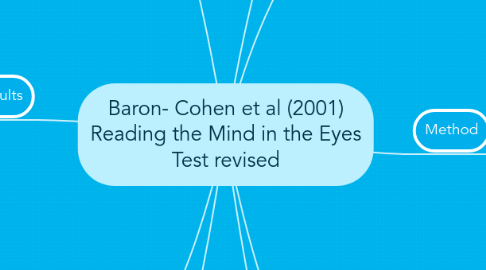Baron- Cohen et al (2001) Reading the Mind in the Eyes Test revised
da Lindsay Round


1. Procedure
1.1. All groups completed in quiet conditions
1.2. Design
1.3. Judging gender of eyes
1.3.1. Normal participants
1.4. AQ questionnaire
1.5. Glossary
1.6. Data from groups 2 and 3
2. Results
2.1. AS/HFA adults
2.1.1. Eyes test
2.1.1.1. AQ
2.2. General population
2.2.1. Eyes test
2.2.1.1. AQ
2.3. Students
2.3.1. Eyes test
2.3.1.1. AQ
2.4. Matched
2.4.1. Eyes test
2.4.1.1. AQ
2.5. Comprehension of words
2.6. AS/HFA adults performed significantly worse on eyes test
2.7. Gender
2.8. Gender recognition in group 1
2.9. AS/HFA adults scored higher on AQ than groups 3 or 4
2.10. Gender on AQ
2.11. AQ and eyes test were inversely correlated
2.12. No correlation eyes test and IQ or AQ and IQ
3. Conclusions
3.1. Inverse correlation
4. Evaluation
4.1. Ecological validity and mundane realism
4.2. Psychomentric tests
4.3. Psychometric tests
4.4. Psychometric tests
4.5. Matched pairs
4.6. Usefulness
5. Context
5.1. Previous research
5.1.1. 1997 study
5.1.1.1. Theory of mind
5.1.1.2. Had found
5.1.1.3. Normal adults were shown to be able to
6. Aims
6.1. AS and HFA
6.2. 'Normal' adults
6.3. Gender
7. Method
7.1. Design problems from original study that were overcome
7.1.1. Forced choice
7.1.1.1. Improvement
7.1.2. Basic mental states
7.1.2.1. Improvement
7.1.3. Eye direction
7.1.3.1. Improvement
7.1.4. Gender
7.1.4.1. Improvement
7.1.5. Semantic opposites
7.1.5.1. Improvement
7.1.6. Comprehension
7.1.6.1. Improvement
7.1.7. Too narrow in scores
7.1.7.1. Improvement
7.2. Target words and foils
7.2.1. Pilot
7.2.1.1. Advantage
7.2.2. In the study
7.2.2.1. Advantage
8. Participants
8.1. Group 1
8.1.1. Sample type
8.1.2. Given IQ test
8.2. Group 2
8.3. Group 3
8.4. Group 4
9. Hypotheses
9.1. 1
9.1.1. 2
9.1.1.1. 3
9.1.1.1.1. 4
